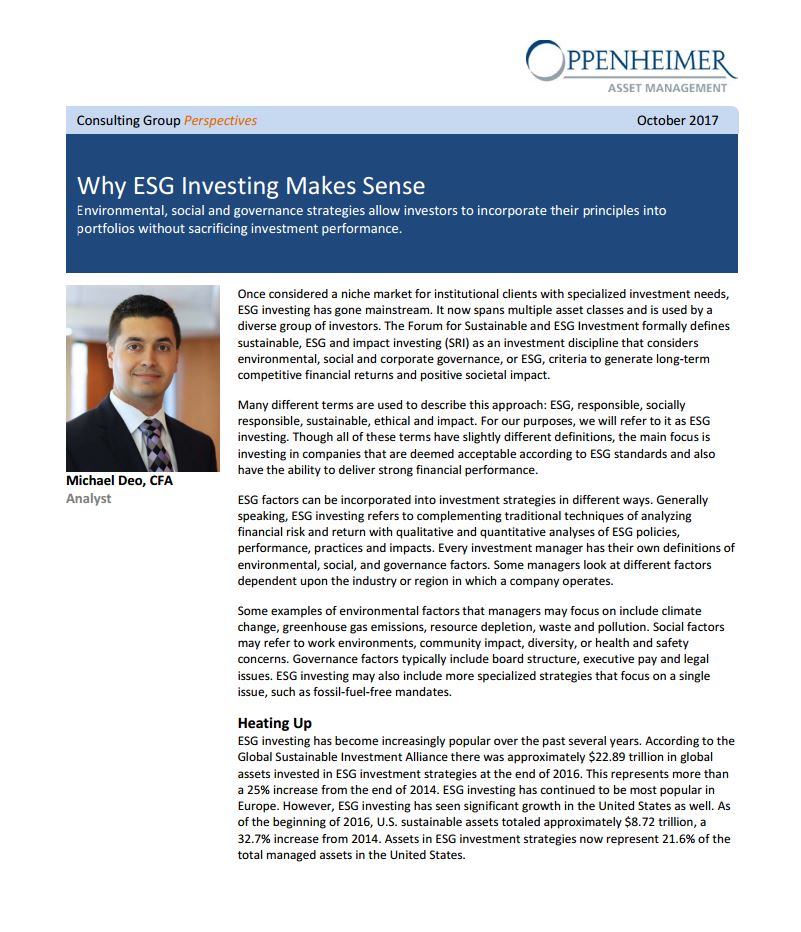Why ESG Investing Makes Sense
By Michael Deo, CFA
 Once considered a niche market for institutional clients with specialized investment needs, ESG investing has gone mainstream. It now spans multiple asset classes and is used by a diverse group of investors. The Forum for Sustainable and ESG Investment formally defines sustainable, ESG and impact investing (SRI) as an investment discipline that considers environmental, social and corporate governance, or ESG, criteria to generate long-term competitive financial returns and positive societal impact.
Once considered a niche market for institutional clients with specialized investment needs, ESG investing has gone mainstream. It now spans multiple asset classes and is used by a diverse group of investors. The Forum for Sustainable and ESG Investment formally defines sustainable, ESG and impact investing (SRI) as an investment discipline that considers environmental, social and corporate governance, or ESG, criteria to generate long-term competitive financial returns and positive societal impact.
Many different terms are used to describe this approach: ESG, responsible, socially responsible, sustainable, ethical and impact. For our purposes, we will refer to it as ESG investing. Though all of these terms have slightly different definitions, the main focus is investing in companies that are deemed acceptable according to ESG standards and also have the ability to deliver strong financial performance.
“Environmental, social and governance strategies allow investors to incorporate their principles into portfolios without sacrificing investment performance.”
ESG factors can be incorporated into investment strategies in different ways. Generally speaking, ESG investing refers to complementing traditional techniques of analyzing financial risk and return with qualitative and quantitative analyses of ESG policies, performance, practices and impacts. Every investment manager has their own definitions of environmental, social, and governance factors. Some managers look at different factors dependent upon the industry or region in which a company operates.
Some examples of environmental factors that managers may focus on include climate change, greenhouse gas emissions, resource depletion, waste and pollution. Social factors may refer to work environments, community impact, diversity, or health and safety concerns. Governance factors typically include board structure, executive pay and legal issues. ESG investing may also include more specialized strategies that focus on a single issue, such as fossil-fuel-free mandates.
Heating Up
ESG investing has become increasingly popular over the past several years. According to the Global Sustainable Investment Alliance there was approximately $22.89 trillion in global assets invested in ESG investment strategies at the end of 2016. This represents more than a 25% increase from the end of 2014. ESG investing has continued to be most popular in Europe. However, ESG investing has seen significant growth in the United States as well. As of the beginning of 2016, U.S. sustainable assets totaled approximately $8.72 trillion, a 32.7% increase from 2014. Assets in ESG investment strategies now represent 21.6% of the total managed assets in the United States.
Disclaimer
Sources: Factset, Bloomberg Financial Services, Zephyr StyleAdvisor, Morningstar Inc.
The returns for the simulated portfolios represent performance of hypothetical allocations and do not represent results of actual accounts. The performance of actual accounts will vary. Performance results for hypothetical allocations have inherent limitations. Such returns do not factor in the effects of economic and market conditions then in existence on the investment manager’s decision-making process if the manager were actually managing client money which would have changed the allocation and results. Additionally, hypothetical allocations are subject to the fact that they were determined with the benefit of hindsight based on the actual performance of the individual manager or index.
Definitions
Indices are unmanaged and presented for comparison purposes only. Please note that the returns displayed for indices do not take into account any of the costs associated with buying and selling individual securities. Individuals cannot invest directly in an index.
Bloomberg Barclays US Aggregate Index (Treasury, Agency, Securitized – MBS, Credit – Corporate). The Bloomberg Barclays US Aggregate Bond Index is a broad-based flagship benchmark that measures the investment grade, US dollar-denominated, fixed-rate taxable bond market. The index includes Treasuries, government-related and corporate securities, MBS (agency fixed-rate and hybrid ARM pass-through), ABS and CMBS (agency and non-agency).
Bloomberg Commodity Index - The Index tracks prices of futures contracts on physical commodities on the commodity markets. The index is designed to minimize concentration in any one commodity or sector. It currently has 22 commodity futures in seven sectors.
BofA ML High-Yield Master Index - a capitalization-weighted Index that provides a broad measure of the performance of the non-investment grade US domestic bond market. The Index is limited to US domestic and Yankee markets. Bonds must have greater than 1 year remaining to final maturity, at least $100 million face outstanding, be US dollar pay, have a fixed coupon schedule with a credit rating below investment grade not in default.
Citigroup Non-USD World Government Bond Index (WGBI) – The Citigroup Non-U.S. Dollar World Government Bond Index is an unmanaged, market-capitalization-weighted index that tracks 10 government bond indices, excluding the United States
FTSE NAREIT All REITs Index – is a market capitalization-weighted index that and includes all tax-qualified real estate investment trusts (REITs) that are listed on the New York Stock Exchange, the American Stock Exchange or the NASDAQ National Market List. The FTSE NAREIT All REITs Index is not free float adjusted, and constituents are not required to meet minimum size and liquidity criteria.
MSCI World ex-USA - The MSCI World ex USA Index captures large and mid-cap representation across 22 of 23 Developed Markets (DM) countries excluding the United States.
MSCI Emerging Markets - The MSCI Emerging Markets Index is an index created by Morgan Stanley Capital International (MSCI) designed to measure equity market performance in global emerging markets.
Russell 1000 Index – a stock market index that represents the highest-ranking 1,000 stocks in the Russell 3000 Index, which represents about 90% of the total market capitalization of that index.
Russell 2000 Index - The Russell 2000 index is an index measuring the performance approximately 2,000 small-cap companies in the Russell 3000 Index, which is made up of 3,000 of the biggest U.S. stocks. The Russell 2000 serves as a benchmark for small-cap stocks in the United States.
Risks
Investing in securities is speculative and entails risk. There can be no assurance that the investment objectives will be achieved or that an investment strategy will be successful. The use of leverage, short sales and derivative transactions, investment in foreign or illiquid securities, and potentially limited diversification, could cause significant losses.
Special Risks of Real Estate Securities
Real estate investing may be subject to a higher degree of market risk because of concentration in a specific industry, sector or geographical sector. Real estate investing may be subject to risks including, but not limited to, declines in the value of real estate, risks related to general and economic conditions, changes in the value of the underlying property owned by the trust and defaults by borrower.
As with any investment, there are risks associated with investing in bonds. These include risks related to interest rate movements (interest rate risk and reinvestment risk), and the risk of credit quality deterioration (credit or default risk). These risks need to be evaluated and effectively managed if the client is to achieve the potential benefits of investing in fixed income securities.
Interest Rate Risk. Interest rate risk is the risk that market interest rate fluctuations result in a decline in the security’s price between the time the investor buys it and the time (before maturity) at which he or she sells it. (The bond’s price will decline when rates rise and vice versa.)
Reinvestment Risk. Reinvestment risk is the risk that the cash flow received from a bond may be reinvested at a lower rate of return. Short-maturity bonds and callable bonds are the instruments most frequently associated with reinvestment risk. Callable bonds may subject the investor to reinvestment risk. Such bonds allow the issuer to repay the principal (with accrued issuer the flexibility to refinance the debt if rates are low or declining. The timing of bond calls occurs precisely when investors do not want to receive their principal back, i.e., when they can only reinvest at either lower rates or in lower-quality securities. To compensate them for this reinvestment risk, investors in callables typically demand (and get) a higher interest rate as compared to non-callables.
Credit or Default Risk. Credit or default risk is the risk that the issuer may be unable to make timely principal and interest payments on the bond. It is the critical determinant of a fixed income security’s quality.
High Yield Fixed Income Risk. High yield fixed income securities are considered to be speculative and involve a substantial risk of default. Adverse changes in economic conditions or developments regarding the issuer are more likely to cause price volatility for issuers of high yield debt than would be the case for issuers of higher grade debt securities. In addition, the market for high yield debt may be less attractive than that of higher-grade debt securities.
Past performance does not guarantee future results.
© 2017 All rights reserved. This report is intended for informational purposes only. All information provided and opinions expressed are subject to change without notice. The information and statistical data contained herein have been obtained from sources we believe to be reliable. No part of this report may be reproduced in any manner without the written permission of Oppenheimer Asset Management or any of its affiliates. Any securities discussed should not be construed as a recommendation to buy or sell and there is no guarantee that these securities will be held for a client’s account nor should it be assumed that they were or will be profitable. The Consulting Group is a division of Oppenheimer Asset Management. Oppenheimer Asset Management is the name by which Oppenheimer Asset Management Inc. ("OAM") does business. OAM is an indirect, wholly owned subsidiary of Oppenheimer Holdings Inc., which is also the indirect parent of Oppenheimer & Co. Inc. ("Oppenheimer"). Oppenheimer is a registered investment adviser and broker dealer. Securities are offered through Oppenheimer. OAM101117CM4

